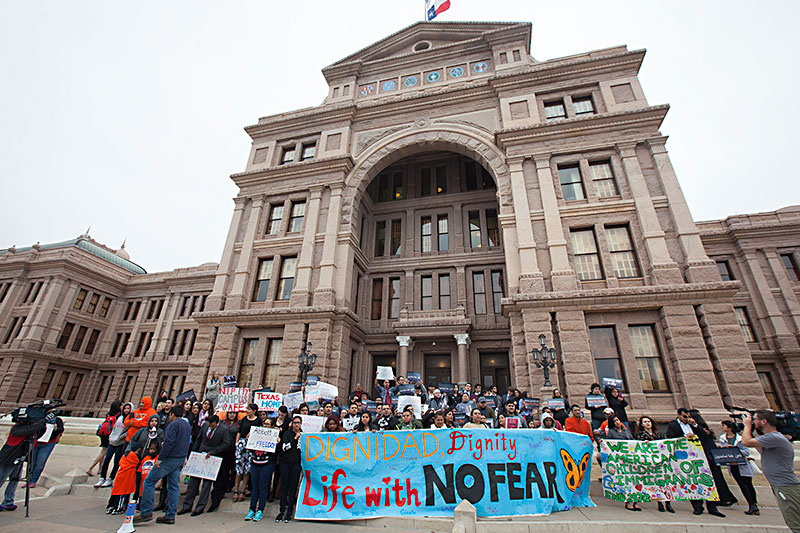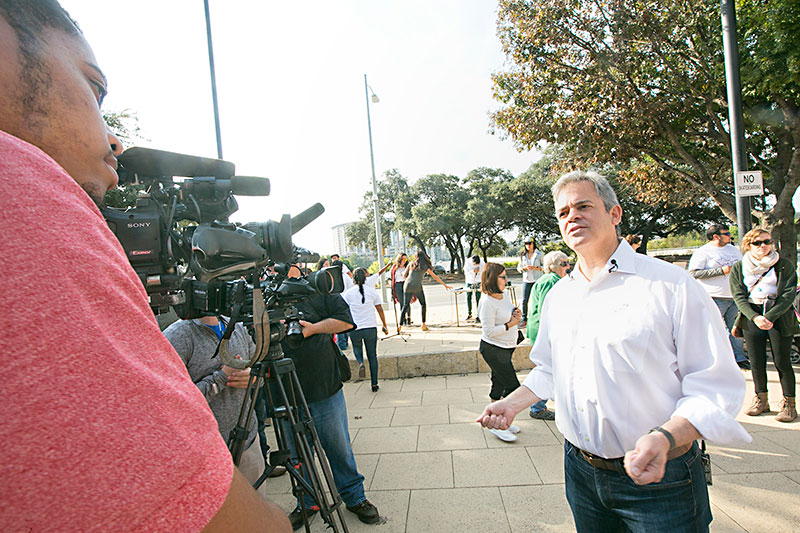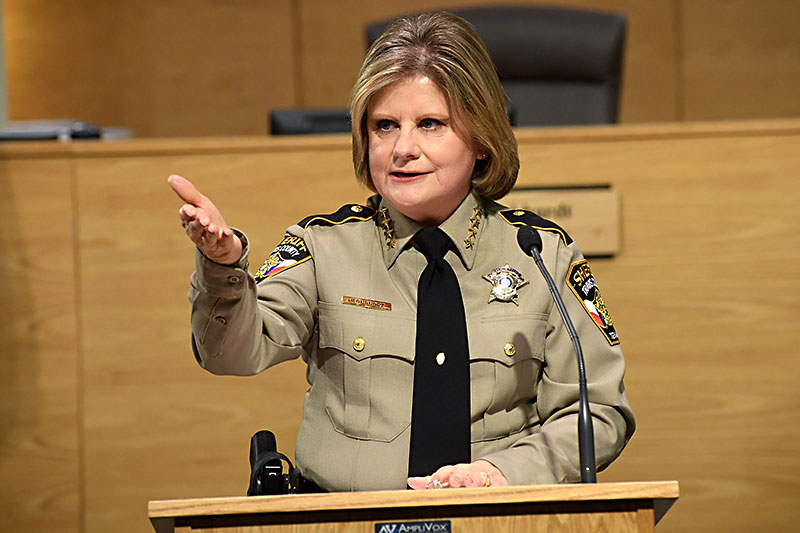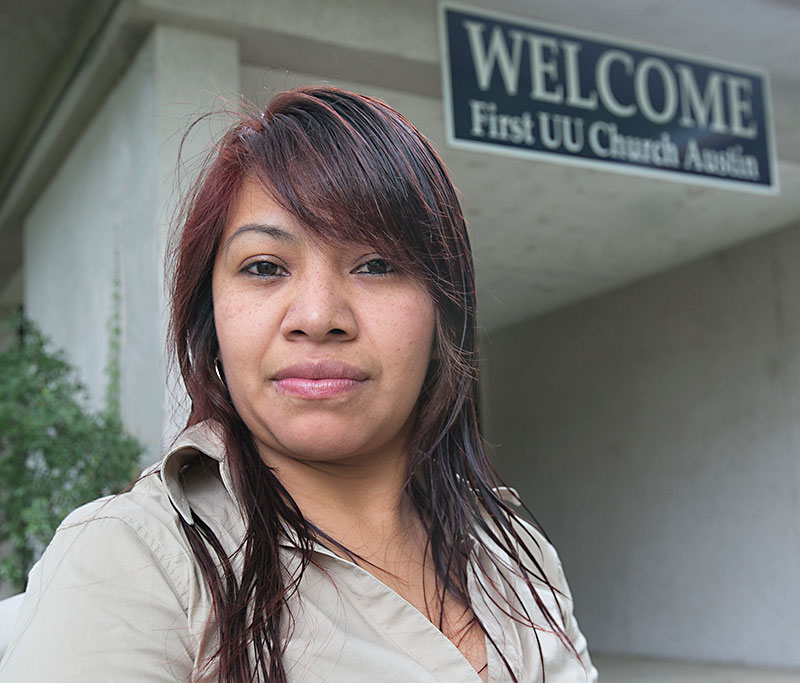Sanctuary Cities and the Ways We Fight for Human Rights
When community matters more than the law
By Victoria Rossi, Fri., Feb. 10, 2017
On the Sunday morning after Donald Trump won the presidential election, Austin Mayor Steve Adler stood in blue jeans and a white button-down shirt before a crowd outside of City Hall. "I understand that you're angry and scared, hurt and confused," he said, pausing so an interpreter could translate his words from English to Spanish. "Many of us are. And that includes me."
Immigrants and allies, also wearing white, had gathered to protest one of then-President-elect Trump's most alarming campaign promises: plans to deport 11 million undocumented immigrants. Austin welcomes immigrants and will stand with them, Adler said, before offering his reassurance in Spanish himself. "Quiero que sepan que sus líderes, en este edificio que se encuentra a nuestras espaldas, nos comprometemos a la seguridad de ustedes y de sus familias," he said. "You need to know that your leaders, in the building behind us, are committed to your safety and your family's."
Adler spoke for 12 minutes. "In Austin, we build bridges, not walls," he said, noting that Austin has long accepted refugees while remaining one of the safest cities in the country. He promised that Austin would join forces with other U.S. cities to protect its vulnerable residents, immigrants among them. "There is great power in cities united," he added.
But throughout his speech, Adler did something interesting. The mayor never referred to Austin as a sanctuary city.
The term "sanctuary city" is a controversial, evocative, and vague one. It bears no legal standard or definition. It's wholly interpretable. For some, the phrase conjures images of the early Christian church offering refuge to the desperate. For others, it alludes to a set of concrete policies that limit a city's cooperation with U.S. Immigration and Customs Enforcement (ICE). In recent years, "sanctuary city" has become a bogeyman for GOP lawmakers, who use it in statements and stump speeches to typify a threat to local safety – or, worse, a symbol of defiance that they will punish. While cities like San Francisco have proudly declared themselves sanctuaries, Austin lawmakers have shied from its use since at least 1985, avoiding the lightning-rod term in favor of more neutral phrasing like "welcoming city."
"Sanctuary city" routinely pits cities against states, as evidenced here in Travis County. On Feb. 1, the Travis County jail stopped releasing inmates to federal immigration authorities – a so-called "sanctuary policy" introduced by the county's new sheriff, Sally Hernandez. That same morning, Gov. Greg Abbott cut $1.5 million in criminal justice grants to Travis County in response to Hernandez's policy. Members of both the state's Senate and House of Representatives have filed anti-sanctuary bills this session – bills that would dramatically affect public safety operations in every Texas city. President Trump has put forth an executive order that would force local law enforcement to cooperate with federal authorities, and even take on the role of immigration agents.
The groundswell raises an important question: Moving forward, what will "sanctuary city" mean to Austin?
Sanctuary as Policy
"Is Austin a sanctuary city?" Sulma Franco considers the question from a booth at a noisy Waffle House, pausing over a plate of eggs. The Guatemalan activist raises her eyebrows: "No," she says, jabbing her fork in the air to punctuate. "No, no, no, no."
Ironically, it is Franco who brought sanctuary to Austin's religious communities. Facing deportation orders, in 2015 she walked through the doors of the First Universalist Unitarian Church and stayed there for 10 weeks until her legal case was temporarily resolved, thus becoming the first person in Texas to claim church sanctuary since the Eighties (see "New Name, Same Game," July 10, 2015). But Franco persists: "The Latino community does not feel that Austin is a sanctuary city – por nada. Not at all."
Fearing deportation, Austin's undocumented immigrants do not feel safe in their daily lives, says Franco. She explains a term widely used in the city's Latino community: polimigra. It's a blend of the Spanish words for "police" and "immigration," reflecting the notion that the two law enforcement entities – one local, one federal – are, in fact, one and the same.
That perception has roots in reality, says Franco. Greg Hamilton, Hernandez's predecessor, who served as sheriff from 2005 through 2016, made no bones about his willingness to work with ICE, the deportation arm of the Department of Homeland Security (DHS). Under its Priority Enforcement Program (PEP), which in 2015 expanded the Bush-era program known as Secure Communities (S-Comm), immigration authorities ask local jails – which are usually run by the county sheriff's department – to hold people after they've been ordered released. These "detainers," as they're called, give ICE time to investigate inmates' immigration statuses and transfer them to a detention center, possibly deporting them.
Federal courts have ruled that ICE detainer requests are just that – requests. During Hamilton's tenure, Travis County honored every such request, resulting in some of the highest deportation rates in the country, according to a 2014 resolution from City Council. Until 2009, the Travis County jail fielded less than 10 detainer requests each year, according to records held by the sheriff's department. That number has since skyrocketed: In the two years between 2012 and 2014, said Council's resolution, Hamilton complied with roughly 5,500 detainers, nearly three-fourths of which were for people whose criminal charges were eventually dropped. In the four years between June 2009 and June 2014, an average of 19 people were deported from the county each week. The Austin American-Statesman reported that nearly 10,000 ICE detainers have been issued in the last decade – more than half for people charged with one misdemeanor. ICE rarely sends warrants with detainers, says professor Elissa Steglich at UT School of Law's immigration clinic. That, in and of itself, is a violation of residents' Fourth Amendment rights to proper search and seizure.
That all changed with Hernandez's election, and, in turn, her Jan. 20 announcement. "Our jail cannot be perceived as a holding tank for ICE," the sheriff, previously a county constable in Precinct 3, said in her filmed statement. She later told the Chronicle: "We in law enforcement have had a difficult time with trust in our community and especially in our communities of color. And so the ability to have these communities feel like it's safe to call and cooperate with us – I feel like it's going to have a huge impact."
Miranda, an undocumented mother from Mexico who historically has avoided contacting police – hesitating even when she discovered her husband was sexually abusing her 8-year-old daughter – agreed. "Wow," she said, when told of the change. "It's so exciting to know we can count on police when we need them."
There are caveats to Hernandez's policy. The sheriff still intends to honor detainers that come with court-ordered warrants. Hernandez also said she will comply with detainer requests of individuals charged with murder, sexual assault, human trafficking, and certain other crimes. But the county policy stands as stark departure from that prescribed by her predecessor, and represents a bold declaration of noncompliance in a state governed by an ICE advocate.
Abbott's response has been equally bold. The governor didn't just cut grants to Travis County, slashing program funds for veterans, prostitution prevention, and families affected by drug use; Abbott also threatened to remove Hernandez, an elected official, from her post. In his State of the State address on Jan. 31, Abbott made sanctuary cities an emergency legislative item and pledged to ban them by the end of the session. Of the many anti-sanctuary bills filed in both state chambers, immigrant advocates most fear SB 4, which would outlaw sanctuary jurisdictions throughout Texas by making detainer requests mandatory. The bill would also strip state money from city, county, and college-campus police for noncompliance. (The Senate voted to approve SB 4 this week, moving it on to the House.)
Such bills are a perennial feature of Texas legislative sessions, but SB 4 has been filed at a time when anti-sanctuary sentiments are particularly intense at both the state and federal level. As mentioned, President Trump also opposes sanctuary policies. On Jan. 25 he issued an executive order requiring full cooperation between DHS and local law enforcement. The order, which has since been challenged in court, would target a broader range of undocumented people, empower state and local law enforcement to act as immigration officers, and create a public bulletin announcing crimes committed by undocumented immigrants – who, according to numerous studies, are less prone to crime than people born in the United States.
Within the city of Austin, police chiefs have testified against state bills that would force their departments to work with federal immigration agencies. But APD lacks written policy concerning its officers' interactions with undocumented immigrants – nothing in its manual prevents officers from asking someone's legal status, for example. City Council Member Greg Casar stressed, however, that APD does not – and will not – work closely with immigration authorities. "Our police officers have neighborhood beats," he said. "They do not have deportation beats. They will not be enforcers of Trump policies or politics." Casar hopes to introduce a resolution soon that would end collaboration not just between immigration authorities and APD, but also the city government.
Sanctuary as Welcome
As lawmakers battle out sanctuary policies, word is taking hold in other spheres. Across the country, universities, businesses, and houses of worship are declaring sanctuary in greater numbers – what's being called the New Sanctuary Movement. Nationally, the number of religious communities offering sanctuary to immigrants doubled to 450 in the weeks following November's election; according to movement leaders, that number is now at 700. In Austin, University of Texas students have joined some 100 schools nationwide clamoring for a "sanctuary campus," with petitions and a student government resolution calling on the university to declare sanctuary; two restaurants – Black Star Co-op and L'oca d'oro – have named themselves sanctuaries; and the interfaith Austin Sanctuary Network has formed to harbor immigrants in need.
"Sanctuary, the idea of saving people who are in danger, of ferrying them to a safe place, of claiming the ancient tradition of churches as sanctuaries; it captures people's emotions in a very powerful way," said Jennifer Long, director of Casa Marianella, a local immigrant shelter. Long said the city of Austin has a "compassionate and reasonable policy," noting City Council's December 2016 resolution to channel funds to legal groups that help immigrants facing deportation. Though she often wonders if the city's efforts will be enough.
"[Former President Barack] Obama deported 2 million people," she said. "There are private prisons. And it's all very invisible to the American people. That's already happening before you even get to Trump." With global refugee crises in the Middle East, Central America, and Africa, the need for spaces like Casa Marianella is now "terrible," said Long. Marianella's beds are overflowing; many sleep on the floor.
Private citizens also sense the need. Cara, a 28-year-old venture capitalist, began renting a room to Ethiopian and Malawian refugees in 2015 for $150 per month – a highly subsidized rate for a Central Austin apartment – after hearing about two German social workers who had offered their extra bedrooms to Syrian refugees, an act that turned into the nonprofit Refugees Welcome. On Saturday (Feb. 4), a federal judge in Washington issued a block on President Trump's travel ban for Syrian refugees and citizens of six other predominantly Muslim countries; the Justice Department quickly appealed the judge's order. Cara said her roommates are very concerned. Neither have been directly affected by the ban, but they wonder which countries will be next.
Offering shelter and support can prove complicated when authorities are involved, said Rev. Babs Miller, a minister at St. Andrew's Presbyterian Church, part of the Austin Sanctuary Network. Since early 2016, St. Andrew's has housed Hilda Ramirez and her son Ivan, a Guatemalan family fleeing death threats and domestic violence. Both held deportation orders that have recently been paused. "We said we wanted to support them and that we were willing to offer sanctuary," Miller recalled. "We said that having no idea what it really meant."
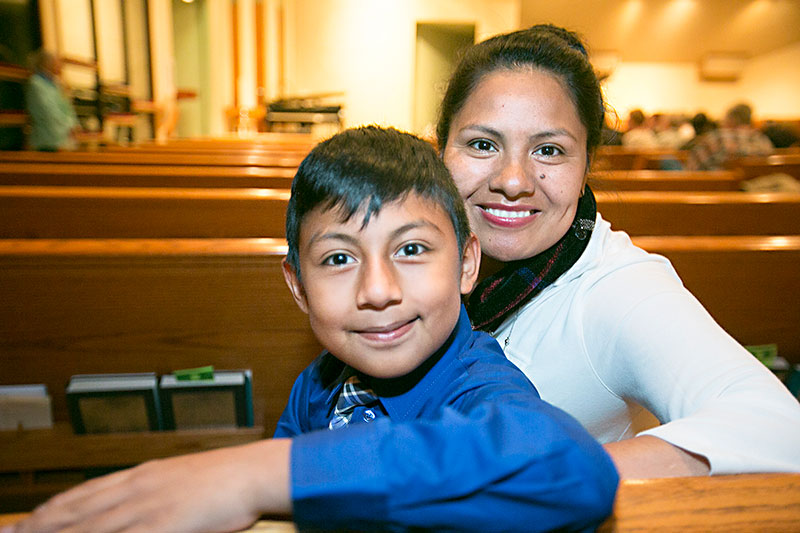
Doing so meant that both the family and the church would incur risk: A 2011 policy memo names "sensitive locations" that ICE will not enter, including churches, schools, and hospitals. But memos can change at the whim of the executive branch – a scary thought under the current administration. Federal authorities have also found workarounds. Reynold Garcia, a Mexican national who had been deported once before, was allegedly lured from a church service in southern Illinois by texts from ICE agents posing as his cousin.
Though many faith communities have offered support to undocumented immigrants, not every house of worship has the resolve or resources to house those fighting their deportation orders in court. St. Andrew's congregants asked themselves what a family in hiding might need. The ministers called for donations; clothing and furniture poured in. Volunteer tutors arrived for both mother and son. When the church threw Ivan a birthday party, residents from the nearby apartment complex brought cakes. The boy's eyes were big, Miller recalled: He'd never had a party, let alone a bouncy castle.
There was also the day-to-day of sanctuary, full of unexpected hang-ups. The sink installed in the converted Sunday school classroom was too high for the tiny woman and boy to reach. The church began to lock its doors. As time passed, Miller said, "the church community gained a great deal more understanding of the immigration system." She spread her hands across the table where she sits, her fingers stretching wide. "You start doing justice work in one area, and it just grows."
Sanctuary as Resistance
As Trump's crackdown on immigration unfolds, the Austin Sanctuary Network has seen requests for sanctuary increase. There may come a day, Miller said, when there is "no room at the inn." Besides, no city or even state can restrict federal authorities from arresting noncitizens – regardless of local law enforcement's cooperation. So they have begun to expand their tactics: Sanctuary in the Streets, a newly formed group modeled after one of the same name in Philadelphia, stands ready to erect its own kind of wall in Austin: a barrier of people willing to stand between immigrants and ICE.
The network of immigrant advocates, attorneys and faith groups is now 150 people strong and growing. New volunteers assembled for a training session in early January at St. Andrew's. "Policy has never saved us," said Alejandro Caceres, an organizer with Grassroots Leadership, who spoke before a large group of Sanctuary in the Streets trainees. Behind him stood an easel marked up with promises from Trump's campaign: Build a wall. Muslim registry. Deport 11 million. Punish sanctuary cities. "We have to rely on ourselves," said Caceres.
"Sanctuary is not passive," he said during a later interview. "Sanctuary is active. We're struggling, we're fighting alongside you. We're saying, 'This person's life matters more to me than the law.' ... It's an act of resistance."
Sanctuary in the Streets does not intend to wait for people to come asking for sanctuary. Rather, the organization aims to disrupt future raids. Rev. Miller told the Chronicle the group practices this scenario: An undocumented immigrant refuses to let an ICE agent into her home without a warrant; she calls a hotline (512/270-1515) that sends a small group of volunteers to the scene. Politely and silently, three or four people edge between the agent and the door, standing shoulder to shoulder. Only one speaks. "We are trained and certified immigration observers," the volunteer will say, as another stands nearby and films. "We have been notified that there is a situation to be observed. May I see your warrant please?"
In training sessions, Miller often plays the role of immigration officer. Sometimes she plays good cop; sometimes she is less lenient. "Does your husband know that you're doing this?" she'll ask one of the role-players, trying to rattle them. She wants to prepare volunteers – mostly white U.S. citizens – for an experience many have never had. "They don't live in a world where cops and immigration officers are confrontational and abusive toward them," said Miller. "I'm trying to help them understand it won't be like, 'Did you realize your blinkers are out, sir?'"
The volunteers must decide what to do if the agent threatens to arrest them, said Miller. Do they stand aside? Or do they stay put, and force the immigration official, who lacks the authority to arrest U.S. citizens, to call for police assistance? "We are using our white privilege to slow down the process," Miller said, noting that it doubles as an effort to buy time for reporters to arrive.
"Enforcement officers do not like media coverage," said Miller.
The reverend stressed that Sanctuary in the Streets' methods are nonviolent, though they are confrontational. "You can play nice and still go after the abuse of power," she said.
Sanctuary in the Streets may be the closest Austin has come to the spirit of the Eighties' Sanctuary Movement, which embraced civil disobedience. Then, the network of churches, synagogues, and safe houses stretched from Mexico to Arizona to Canada, sheltering and transporting roughly 1 million refugees. In Texas, sanctuary workers drove to the border to pick up Central Americans fleeing civil wars and genocides that activists accused the United States of fomenting. Informants infiltrated their network, stoking division and paranoia. Eighteen people – including nuns, priests, and a minister – were jailed and indicted for smuggling aliens.
Miller is hopeful that today's circumstances won't reach that point. Immigrants in 2017 have more grassroots support, she said. The Eighties movement came before the internet and was more isolated. The shift toward a more resistant strand of sanctuary is a result of that effort. "We're standing on their shoulders," Miller said.
When Sulma Franco declared sanctuary in the Unitarian church, she was not well-versed in this history. She calls her stay a mistake-filled learning process. But while the declaration was a cry for help, it was also a show of strength. With the help of her girlfriend and UT students, Franco built the chain-link fence that surrounded her church living quarters. "I wanted to show other women that we don't have to be scared all the time, that we can do something to defend ourselves."
Hilda Ramirez and her son followed Franco's lead. Though 28, Ramirez appears younger, with round cheeks and a quiet, measured way of speaking Spanish. Mam, an indigenous language, is her native tongue.
Ramirez was fearful when she first came to St. Andrew's. She jumped at small noises and anxiously watched the sheriff's patrol cars that were camped outside, knowing their presence was routine but still unable to shake the feeling that sheriff's deputies were watching her. Having spent 11 months in a family detention center with her son just seven months before that, she felt terribly sad to be confined again – even in a kind place like St. Andrew's. During her first week, Ramirez recalled, pastors asked if she wanted to meet the congregation. Ramirez said no. "I stayed in my room," she said, pulling her arms close as if clutching a blanket. The second Sunday, she was ready to meet the church.
Rev. Miller believes Ramirez's arrival made it clear to the congregants what was at stake with sanctuary. "What will you do if Immigration comes?" Caceres asked the churchgoers. He pretended to be an ICE officer. "We're here for Hilda Ramirez," he called out into the church.
The members began to move. Ramirez suddenly found herself in a circle deep with people. Some blocked the doorway. Others formed an outer ring. More pushed closer, she recalled, linking elbows together, saying to her, "We're not going to let them take you. You're safe."
"I'd felt so alone," Ramirez said, her slow-moving Spanish suddenly picking up pace, animating. "And now there was everyone, who'd come to protect me without even knowing me. All, all of the church! I'm so small – all I could see was their backs. I felt so much joy. I was crying. There I was made invincible."
Got something to say on the subject? Send a letter to the editor.





